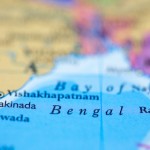The economic crisis in Sri Lanka, with restrictions on imports and queues for essential commodities, is a reminder of why infrastructure spending needs to be financially responsible and sustainable. This is an important consideration as India seeks to build links with its neighbours in the Bay of Bengal region – Myanmar, Bangladesh, Sri Lanka and Thailand.
The Bay of Bengal is a natural bridge between South Asia and Southeast Asia, and is gaining economic and strategic relevance as a significant sub-region within the Indo-Pacific. Almost 1.4 billion people live in the surrounding countries and almost one-quarter of the global trade in goods cross these waters every year. However, connectivity within the region, and especially between India and its eastern neighbours is lacking, as a recent study by Gateway House shows. India’s Act East policy seeks to build greater connectivity with its Bay of Bengal partners, but progress on the ground has been slow.
This has given China space to step in – with mega projects under the Belt and Road Initiative (BRI) umbrella. China has been a clear winner in the physical connectivity stakes in the Bay of Bengal because of its strategic planning, large scale investments and ambitious scope. It has invested heavily in the maritime infrastructure of the region, although the projects have not always benefitted the host country. The Hambantota Port in Sri Lanka is already a white elephant. Other proposed projects such as the Kyauk Pyu port in Myanmar and the Kra canal in Thailand are likely to end up similarly, if executed in their original form.
While India cannot match China’s cheque-book diplomacy, it can use a combination of physical, technological and financial projects to improve regional connectivity.
First energy, of which there is a regional shortage. A regional power grid will allow hydropower rich Nepal and Myanmar to sell electricity to Bangladesh, India and Thailand. So far, both countries lack funds to build hydropower plants. Access to electricity markets of India and Bangladesh will enable Myanmar and Nepal to raise funds for building their own hydropower projects.
The Bay of Bengal states can form a special purpose vehicle (SPV) company to set up the regional grid, with regional governments as shareholders. This could be a model for collaboration on other large projects that seek to promote regional connectivity, such as railways or ports. Countries like Japan and Australia, which are a part of the Indo-Pacific and also the Quad, can be brought in as shareholders. The oversight provided by this kind of experienced syndicate, will prevent small states from having to accept unsustainable projects. It will also be difficult for a single country to dominate the infrastructure sector.
However, investments in physical connectivity will take time. And there are often political complications, such as the coup in Myanmar and insurgencies in various Bay of Bengal states, which can delay such projects.
Therefore, in addition to physical infrastructure, the region must simultaneously focus on other forms of connectivity – digital/virtual/tech connectivity, which is easier to finance and achieve.
Here, India has a significant role to play. The country has a vibrant startup sector, with 30 startups crossing the $1 billion valuation mark in 2021 already, and more in the pipeline. Most of these are in areas that directly touch lives of a large number of people and many of these create opportunities for small entrepreneurs, farmers, skilled craftsmen etc. Unlike mega-infrastructure, which is top down, these startups aim to solve everyday problems and are more bottom-up, and are less impacted by systemic inefficiencies that plague physical infrastructure. They also rely on a far larger ecosystem of investors, as opposed to the multilateral institutions which are controlled by a few governments. Because these startups are privately funded, investments will not lead to debt traps.
However, the Indian and foreign and tech investors backing Indian startups rarely venture into the relatively smaller markets of Sri Lanka, Bangladesh and Nepal. This is where governments and multilateral bodies can play a helpful role.
A Bay of Bengal venture fund, seeded with capital from local governments but without government control, can be one way to improve regional financial and digital connectivity. The new interest of the Quad countries in the Indo-Pacific – which includes the Bay of Bengal – can work in the region’s favour. The aid agencies of the U.S., Japan and Australia already provide significant assistance in the region. Some of this assistance can be redirected towards funding startups with a social impact in sectors such as agri-tech, fintech and healthcare. With multilateral funding available, these startups will enable the creation of a local tech ecosystem and better access to seed/venture funding for new entrepreneurs. In their joint statement on 24th September 2021, the Quad members have reaffirmed their support for the Blue Dot network, which certifies infrastructure projects for transparency and sustainability. The grouping also emphasized the importance of free, fair and transparent lending practices. Supporting tech startups will also enable these safeguards for digital infrastructure.
The tech sector can transform lives, as India is witnessing. It is less hampered by the issues that have plagued traditional hard, big-ticket infrastructure. With tech, investments required is smaller and the outcomes are quickly evident. With India’s unicorns on an upswing, the demonstration effect and similar investments made in on the Bay of Bengal countries can rev up this crucial economic regional engine.
This article was first published in The Hindustan Times.
Amit Bhandari is Fellow, Energy and Environment Studies Programme, Gateway House.
Read the paper, ‘Unfinished Connectivity in the Bay of Bengal’ here.


